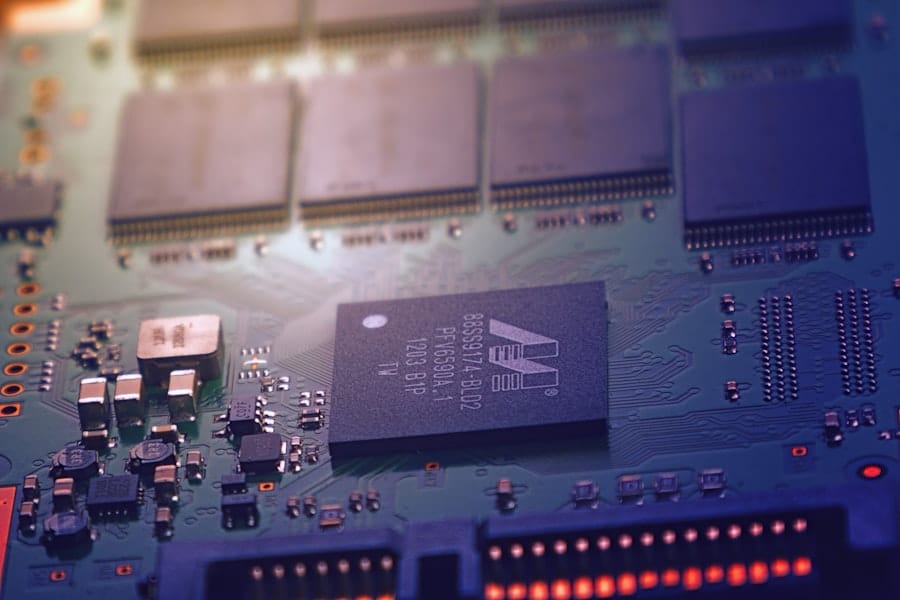Spintronics, or spin electronics, is an innovative field that leverages the intrinsic spin of electrons, in addition to their charge, to develop new types of electronic devices. This burgeoning area of research has the potential to revolutionize the way we think about and utilize electronic components. Unlike traditional electronics, which primarily rely on the flow of electric charge, spintronics exploits the magnetic moment associated with electron spin, allowing for new functionalities and enhanced performance in various applications.
The concept emerged in the late 20th century, gaining traction as researchers began to explore the implications of electron spin in solid-state physics. The significance of spintronics lies in its ability to create devices that are not only faster but also more energy-efficient than their classical counterparts. As the demand for faster processing speeds and lower power consumption continues to grow, particularly in the realms of computing and data storage, spintronics offers a promising alternative.
By harnessing the unique properties of electron spin, researchers aim to develop next-generation technologies that could lead to breakthroughs in information processing, storage, and even quantum computing.
Key Takeaways
- Spintronics is a field of study that focuses on the manipulation of electron spin to create new electronic devices and technologies.
- Classical electronics face limitations in terms of power consumption, heat generation, and speed, which can be overcome by spintronics.
- Spintronics works by utilizing the spin of electrons, in addition to their charge, to store and manipulate information.
- Advantages of spintronics over classical electronics include lower power consumption, faster data processing, and potential for higher storage capacity.
- Current applications of spintronics include magnetic random-access memory (MRAM), spin transistors, and spin-based logic devices, with potential for use in quantum computing and spin-based sensors in the future.
The Limitations of Classical Electronics
Classical electronics has served as the backbone of modern technology for decades, but it is not without its limitations. One of the primary challenges is the increasing difficulty in miniaturizing components while maintaining performance. As transistors shrink to nanometer scales, issues such as quantum tunneling and increased power dissipation become significant hurdles.
” This term refers to the observation that the number of transistors on a microchip doubles approximately every two years, a trend that is becoming increasingly difficult to sustain. Moreover, classical electronic devices are inherently limited by their reliance on charge transport. This reliance results in significant energy loss in the form of heat, which not only reduces efficiency but also poses challenges for thermal management in densely packed circuits.
As devices become more complex and integrated, managing heat dissipation becomes a critical issue. The limitations of classical electronics highlight the need for alternative approaches that can overcome these challenges and provide a pathway toward more efficient and powerful technologies.
How Spintronics Works
At the heart of spintronics is the concept of electron spin, which can be thought of as a tiny magnetic moment associated with each electron. Electrons can exist in one of two spin states: “up” or “down.” This binary nature allows for the encoding of information in a manner similar to classical bits, but with added complexity and potential. In spintronic devices, information is stored not just in the presence or absence of charge but also in the orientation of electron spins.
This duality opens up new avenues for data manipulation and storage. Spintronic devices typically utilize materials that exhibit ferromagnetism or antiferromagnetism, where the alignment of spins plays a crucial role. For instance, in magnetic tunnel junctions (MTJs), two ferromagnetic layers are separated by a thin insulating barrier.
The resistance of this junction depends on the relative alignment of the spins in the two layers—parallel alignment results in lower resistance, while antiparallel alignment leads to higher resistance. By controlling the spin states through external magnetic fields or electrical currents, it is possible to manipulate the flow of electrons and thus encode information efficiently.
Advantages of Spintronics over Classical Electronics
The advantages of spintronics over classical electronics are manifold and significant. One of the most compelling benefits is the potential for non-volatile memory storage. Traditional memory technologies, such as dynamic random-access memory (DRAM), require constant power to maintain data integrity.
In contrast, spintronic memory devices can retain information even when power is removed, making them ideal candidates for applications requiring fast access times combined with low power consumption. Additionally, spintronic devices can operate at much higher speeds than conventional electronic components. The manipulation of electron spins can occur on timescales much shorter than those associated with charge transport, enabling faster data processing capabilities.
This speed advantage is particularly relevant in applications such as high-performance computing and data centers, where rapid access to large volumes of data is essential. Another notable advantage is the reduced energy consumption associated with spintronic devices. Since they rely on spin rather than charge for information processing, they can achieve significant reductions in power usage.
This characteristic is particularly important in an era where energy efficiency is paramount due to environmental concerns and rising operational costs in data centers and electronic devices.
Current Applications of Spintronics
Spintronics has already found its way into several practical applications, demonstrating its potential to transform various sectors. One prominent example is magnetic random-access memory (MRAM), which utilizes spintronic principles to store data. MRAM combines the speed of SRAM with the non-volatility of flash memory, making it an attractive option for applications ranging from consumer electronics to enterprise-level data storage solutions.
Companies like Everspin Technologies have successfully commercialized MRAM products that offer faster read/write speeds and greater endurance compared to traditional memory technologies. Another area where spintronics is making an impact is in the development of advanced sensors. Spintronic sensors are capable of detecting minute changes in magnetic fields with high sensitivity and precision.
These sensors have applications in various fields, including automotive technology for anti-lock braking systems and industrial automation for monitoring equipment performance. Furthermore, researchers are exploring the use of spintronic devices in quantum computing, where they could serve as qubits—fundamental units of quantum information—due to their ability to maintain coherence over longer timescales compared to other systems.
Challenges and Future Potential of Spintronics
Despite its promise, spintronics faces several challenges that must be addressed before it can achieve widespread adoption. One significant hurdle is material compatibility; many spintronic devices require specific materials that may not be easily integrated with existing semiconductor technologies. The search for new materials that exhibit desirable spintronic properties while being compatible with current fabrication techniques is an ongoing area of research.
Another challenge lies in the scalability of spintronic devices. While laboratory demonstrations have shown impressive results, translating these findings into commercially viable products requires overcoming issues related to manufacturing processes and cost-effectiveness. Researchers are actively investigating ways to simplify fabrication methods and reduce production costs to make spintronic technologies more accessible.
Despite these challenges, the future potential of spintronics remains bright. As research continues to advance our understanding of electron spin and its applications, we may see breakthroughs that enable new functionalities and improved performance across a range of technologies.
The Role of Spintronics in Advancing Technology
Spintronics plays a crucial role in advancing technology by providing solutions that address some of the most pressing challenges faced by classical electronics. As we move toward an increasingly digital world characterized by big data, artificial intelligence, and ubiquitous connectivity, the demand for faster and more efficient processing capabilities will only grow. Spintronic devices offer a pathway to meet these demands by enabling high-speed data transfer and low-power operation.
Moreover, spintronics has implications beyond traditional computing and storage applications. Its principles can be applied to develop novel devices such as logic gates that operate on spin rather than charge, potentially leading to more efficient computing architectures. Additionally, advancements in spintronic materials could pave the way for new types of sensors and actuators that enhance our ability to interact with and understand our environment.
The integration of spintronics into existing technologies could also lead to significant improvements in energy efficiency across various sectors. For instance, incorporating spintronic components into communication networks could reduce power consumption while increasing data transmission rates. As industries strive for sustainability and reduced environmental impact, spintronics presents an opportunity to create greener technologies that align with these goals.
The Future of Spintronics
The future of spintronics holds immense promise as researchers continue to explore its potential applications and address existing challenges. With ongoing advancements in materials science and fabrication techniques, we may soon witness a new era of electronic devices that leverage electron spin for enhanced performance and efficiency. As industries increasingly prioritize energy efficiency and speed, spintronics stands poised to play a pivotal role in shaping the next generation of technology.
As we look ahead, collaboration between academia and industry will be essential for translating theoretical advancements into practical applications. By fostering partnerships that bridge research and commercialization efforts, we can accelerate the development and adoption of spintronic technologies across various sectors. The journey toward realizing the full potential of spintronics is just beginning, but its impact on future technological innovations promises to be profound and far-reaching.
In a recent article on ENICOMP, the top 10 best laptops for SolidWorks in 2023 were highlighted in an expert guide featuring Lenovo and Dell workstations. This article provides valuable insights into the best laptops for professionals working in design and engineering fields, showcasing the importance of choosing the right technology for specific tasks. As spintronics continues to revolutionize the field of electronics, having the right tools and devices becomes increasingly crucial for maximizing efficiency and productivity. To read more about the best laptops for SolidWorks, check out the article here.
FAQs
What is spintronics?
Spintronics, or spin electronics, is the study of the intrinsic spin of electrons and its associated magnetic moment, in addition to its fundamental electronic charge, in solid-state devices.
How does spintronics differ from classical electronics?
Classical electronics relies on the charge of electrons to carry information, while spintronics utilizes the spin of electrons to store and transmit data. This allows for potentially faster, more efficient, and lower power consumption devices.
What are the potential advantages of spintronics over classical electronics?
Spintronics has the potential to enable the development of smaller, faster, and more energy-efficient electronic devices. It could also lead to the creation of new types of devices, such as spin-based transistors and spin-based memory.
What are some current applications of spintronics?
Spintronics is already being used in some commercial products, such as magnetic sensors in hard drives and magnetic random-access memory (MRAM) in some electronic devices.
What are the challenges in replacing classical electronics with spintronics?
One of the main challenges is developing materials and devices that can operate at room temperature and be easily integrated into existing semiconductor technologies. Additionally, the scalability and manufacturability of spintronic devices need to be addressed for widespread adoption.



